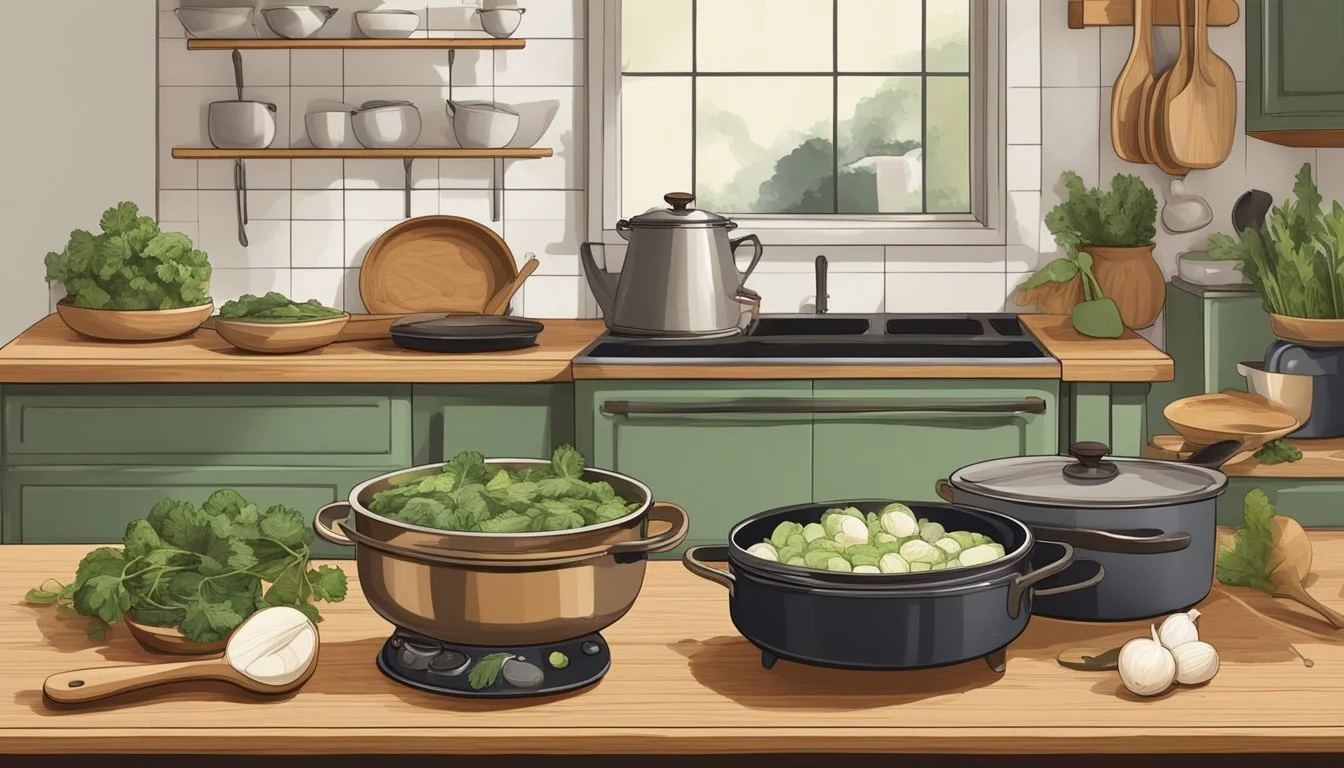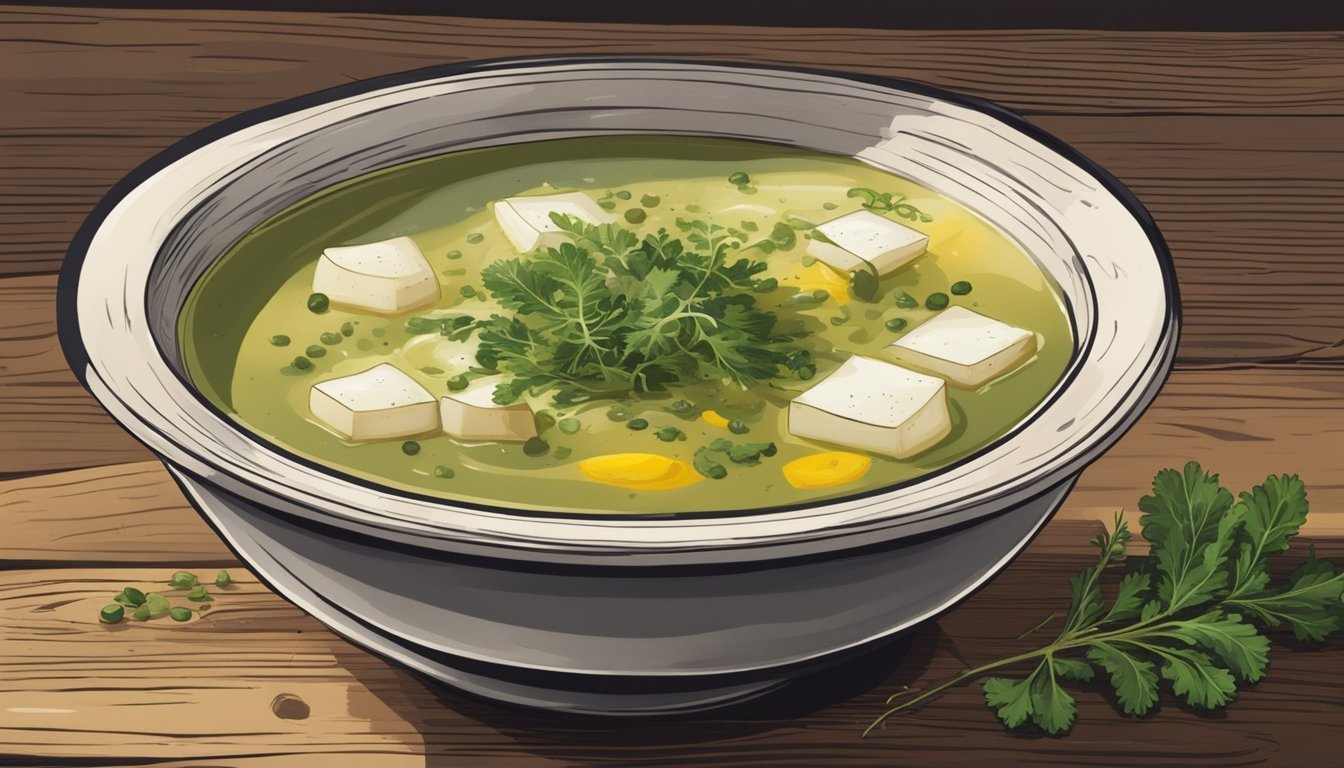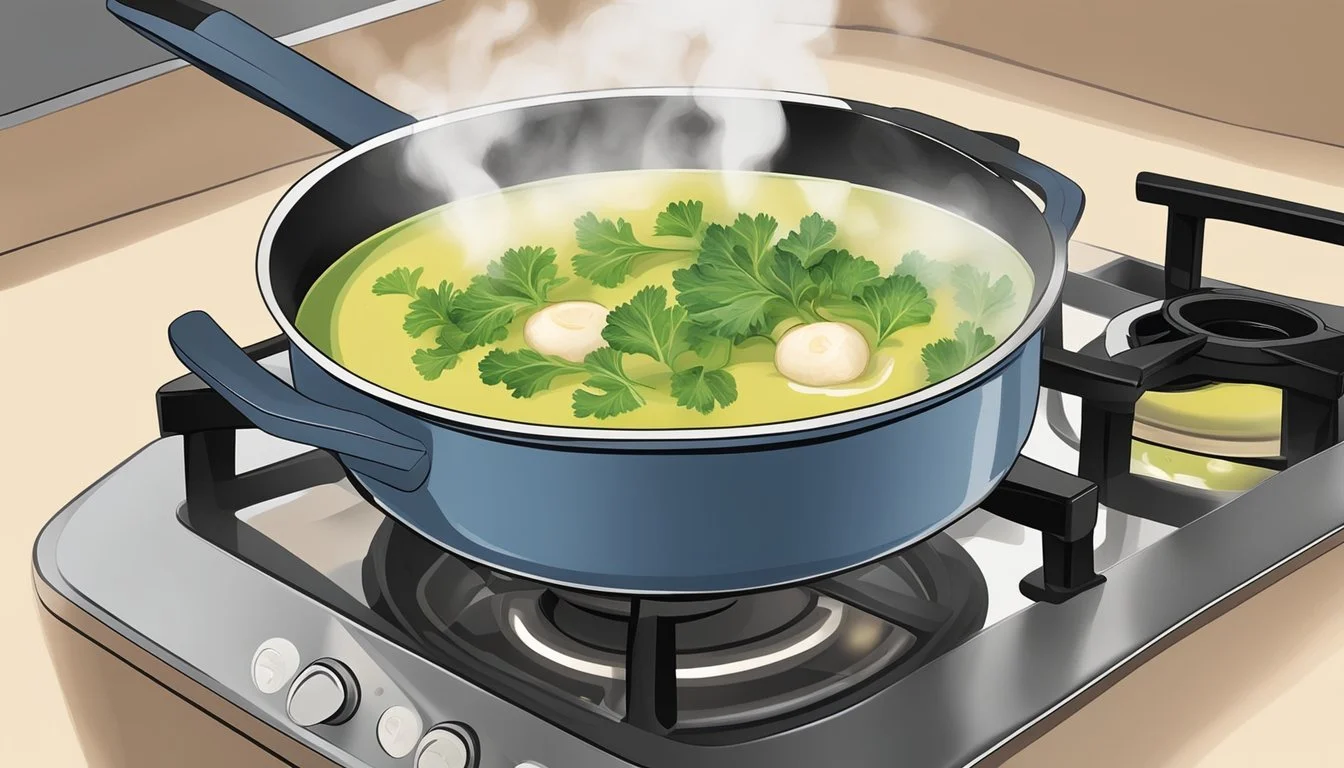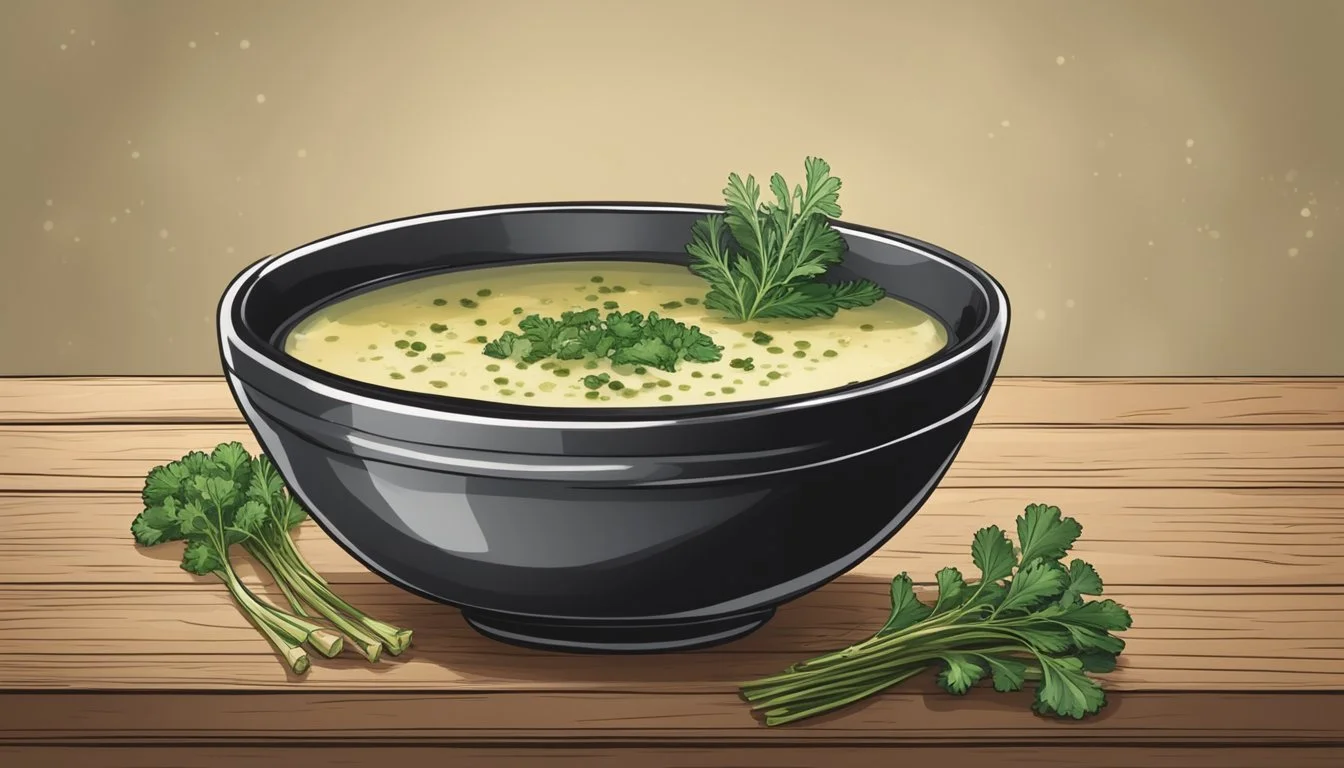Turnip Top Soup
The Perfect Recipe for a Peppery, Comforting Starter
Turnip top soup emerges as a culinary delight that represents the essence of comfort food. Often crafted from the leafy greens of the turnip plant, which are frequently discarded, this soup offers not only a peppery kick but also an opportunity to engage in sustainable cooking practices. The soup is a testament to the versatility of turnips, extending beyond the root to the nutrient-rich tops that provide a unique flavor profile and a wealth of vitamins.
As the seasons change and the air grows cooler, a bowl of turnip top soup serves as a comforting starter that soothes the soul and warms the body. This dish is traditionally seasoned to taste and simmered to a velvety consistency, often paired with a hearty slice of crusty bread. Its peppery notes and creamy texture invite diners to appreciate the humble turnip in a new and inviting way.
Whether it's dressed up with a drizzle of infused oil or served in its simplest form, turnip top soup is a celebration of the bounties of the garden. It stands as a reminder that comfort can be found in the most unassuming ingredients, while its preparation speaks to the skill of transforming the ordinary into the extraordinary.
Exploring Turnip Tops
Turnip tops, often hailed for their nutritional value, are the leafy greens of the turnip plant. They are not only versatile in cooking but also packed with a wealth of vitamins and minerals. Turnip tops are particularly high in fiber, which aids digestion, and are an excellent source of vitamins such as vitamin C, K, A, and folate.
The turnip greens enrich dishes with not just nutrition but also with a peppery flavor that resembles mustard greens. Their robustness adds character to the mild, rooty essence of the turnip bulb, creating a balanced taste profile.
In terms of minerals, turnip tops are known to be a good supply of calcium, important for bone health, as well as potassium, which contributes to better heart functioning. They also provide a modest amount of iron, which is vital for transporting oxygen in the blood.
Here is a breakdown of their nutrition per 100g serving:
Calories: Low
Fiber: About 3.5g
Vitamin C: About 60mg
Calcium: About 190mg
Potassium: About 296mg
Iron: About 1.1mg
Folate (Vitamin B9): About 145μg
One should not overlook the culinary potential of turnip greens. They can be sautéed, steamed, or blended into soups (What wine goes well with soups?) for a nourishing addition. When preparing turnip top soup, it's important to wash the greens thoroughly to remove any dirt and to chop them into bite-sized pieces for ease of cooking. Whether used as a key ingredient or a garnish, turnip tops add both nutritional value and a peppery zing to the soup.
Essential Ingredients
The right blend of ingredients is crucial to creating a harmonious Turnip Top Soup. A selection of root vegetables partners with a flavorful liquid base, enhanced by carefully chosen seasonings and garnish.
Turnips and Their Companions
For the soup's foundation, one should employ:
Turnips: The star, offering a slightly sweet and peppery taste.
Carrots: For sweetness and color.
Potatoes: Adds thickness and heartiness.
Onions: (What wine goes well with onions?) Brings a subtle sharpness.
Garlic: A must-have for depth.
In combination, these vegetables create a robust base for the soup, complementing the turnips with sweetness and body.
Liquids for Simmering
A proper simmering liquid adds both flavor and consistency:
Water: A neutral choice that relies on seasoning to shine.
Chicken broth: Introduces a savory note.
Vegetable broth: Makes for a vegetarian-friendly option.
Stock: Can be either vegetable or chicken, imparting richness.
Simmering these liquids with the vegetable mix allows for a full intermingling of flavors.
Flavor Enhancers
To elevate the taste:
Salt and Pepper: Fundamental seasoning duo.
Herbs: Thyme or rosemary introduce earthy notes.
Olive Oil or Butter: For sautéing onions and garlic, enhancing their flavors.
Cream or Sour Cream: For added richness and a creamy texture.
Incorporating these enhances the natural flavors of the vegetables and adds layers of complexity.
Nutritional Additions
To boost the nutritional profile:
Kale or Cabbage: Adds fiber and vitamins.
Root Vegetables: Like butternut squash, cauliflower, or radish can be included for variety.
Parmesan: Offers a punch of umami and richness.
These elements make the soup not just a treat for the palate but also a wholesome meal.
Step-by-Step Cooking Guide
In crafting Turnip Top Soup, precision in preparation leads to a rich flavor profile and nourishment. Each step, from the careful preparation of vegetables to the delicate finishing touches, is essential to create this comforting starter.
Preparation of Vegetables
Ingredients:
Method:
Wash all vegetables thoroughly to remove any dirt and residue.
Peel the turnips and carrots, and then chop them into consistent sizes to ensure even cooking.
Finely dice the onion and mince the garlic, as they are foundational for the soup’s flavor.
The Cooking Process
Ingredients:
Olive oil or butter
Vegetable stock or water
Red pepper (optional)
Salt
Pepper
Method:
In a large stock pot, heat olive oil or melt butter over medium-high heat.
Saute the onion until it's soft, followed by carrot and garlic, stirring frequently to release their flavors.
Add the turnips and saute for a few more minutes before introducing the punchy turnip tops.
Once the vegetable tops begin to wilt, pour in the stock or water and season with salt, pepper, and red pepper if desired.
Bring the soup to a boil, then reduce to a simmer and let it cook until all vegetables are tender.
Finishing Touches
Ingredients:
Cream (optional)
Parsley, croutons, or roasted turnips for garnish
Method:
Use an immersion blender or transfer soup into a countertop blender to blend until smooth. Achieve desired consistency by adding water if the soup is too thick.
For a creamier texture, stir in some cream as per the desired richness and nutritional balance.
Serve the turnip top soup hot, with a sprinkle of fresh parsley, a handful of croutons, or a few pieces of roasted turnips to counter any bitterness and add a textural contrast.
Soup Variations and Accompaniments
When crafting a comforting bowl of Creamy Turnip Soup, variations abound to suit vegetarian diets or those seeking a hearty appetizer with a balance of carbohydrates, protein, and fat. Tailoring the soup's creamy base can cater to dietary preferences while still delivering a satisfying dish.
For a velvety texture with fewer saturated fats, one might opt for a mashed turnip soup incorporating vegetable broth and light sour cream or a splash of heavy cream. Swapping out heavy creams with coconut milk can make the soup approachable for those watching their cholesterol intake without sacrificing creaminess.
To add complexity and depth, the inclusion of apples offers a balanced sweetness, while a sprinkle of kosher salt heightens the natural flavors. For an inviting savory note, a garnish of crispy bacon bits or a dusting of Parmesan cheese on top adds a delightful crunch and richness. One could also consider a roasted variation, where turnips are oven-baked to enhance their sweetness, then pureed into a creamy concoction.
Continuing the journey of flavors, one can experiment by stirring in a teaspoon of curry powder for warmth, a hint of ginger for zing, or a drizzle of vinegar for a subtle tang. Meanwhile, a side of turnip fries—especially when made from sweet potatoes—brings a comforting and substantial component, perfect for dipping into the creamy soup.
Here's a succinct guide for accompaniments:
Accompaniment Role Note Parmesan Cheese Garnish Adds sharpness and richness Bacon Bits Garnish Introduces a savory crunch Apple Cider Vinegar Flavor enhancer Gives a bright, acidic contrast Ginger Spice Presents a fresh, zesty kick Curry Powder Spice Offers warmth and complexity Sweet Potato Fries Side Serves as a sweet and hearty companion Sour Cream Creaminess modifier Provides tang and reduces fat content
Each variation and accompaniment invites personalization to this classic, comforting dish, allowing one to adapt not just to tastes but also to nutritional needs, creating a culinary experience as robust and varied as the ingredients themselves.
Serving and Presentation
A successful presentation enhances both the visual charm and appetite appeal of Turnip Top Soup, making it a truly comforting and flavorful starter. The right garnishes and side pairings can transform this soup from a simple dish to an elegant culinary experience.
Plating Techniques
When plating, one should ladle the soup gently into a pre-warmed bowl to maintain its temperature. A drizzle of high-quality olive oil can add a sheen to the surface, while a sprinkle of finely grated Parmesan cheese introduces a savory note. For texture, a handful of homemade croutons provides a delightful crunch. Lastly, a garnish of fresh parsley is not only eye-catching but also infuses a subtle, fresh flavor that complements the peppery tones of the soup.
Soup Pairings
To create a well-rounded meal, they should consider serving Turnip Top Soup with a variety of side dishes. A crusty piece of bread or a hearty sandwich can balance the meal, while salads with crisp greens provide a refreshing contrast to the soup’s creamy texture. For heartier appetites, a side of roasted vegetables amplifies the comforting aspect of the meal. Each pairing should be chosen to complement the rich and warm flavors of the soup without overshadowing it.
Nutrition and Health Benefits
Turnips, the primary ingredient in Turnip Top Soup, stand out for their impressive nutritional value. A low-calorie vegetable, they contribute a variety of vitamins and minerals integral to overall health. One cup of raw turnips provides significant dietary fiber, supporting digestive health.
Turnips are particularly rich in:
Vitamin C: essential for immune function and skin health.
Fiber: aids in digestion and maintains satiety.
Potassium: contributes to heart health by regulating blood pressure.
Besides these, turnips offer modest amounts of protein and are considered low-carb, making them suitable for various diets. Their glycemic index is low, which may help in managing blood sugar levels.
In terms of minerals, turnips contain:
Calcium: vital for bone health.
Iron: crucial for transporting oxygen in the blood.
Folate: important for cell growth and function.
The green tops of the turnip, often used in the soup, are also nutritious, providing additional nutrients such as vitamin A, essential for good vision and immune health.
Here is a quick glance at the nutrient profile:
Nutrient Benefit Vitamin C Immune support, skin health Fiber Digestive health, satiety Potassium Heart health Protein Muscle maintenance Calcium Bone health Iron Oxygen transport Folate Cell growth and function Vitamin A Vision and immune health
Including Turnip Top Soup at the beginning of a meal can be a comforting starter that not only warms the palate but also confers these essential nutrients contributing to one's overall diet.
Storage and Reheating Tips
When it comes to storing Turnip Top Soup, the approach is straightforward. Freshly made soup should be allowed to cool to room temperature before storing to maintain its quality. It can be kept in the refrigerator in an airtight container; this ensures the soup remains fresh for consumption.
Refrigeration:
Duration: Refrigerate leftover Turnip Top Soup for up to 3-4 days.
Container: Use an airtight container to prevent absorbing other flavors from the fridge.
Freezing:
Turnip Top Soup can be frozen for longer storage. Here's the method:
Cool the soup completely.
Portion the soup into freezer-safe bags or containers.
Freeze for up to 2-3 months.
Reheating:
When one is ready to enjoy the leftover Turnip Top Soup, they have a couple of options:
Stovetop: Pour the soup into a pot and reheat on medium heat, stirring occasionally until hot.
Microwave: For a single serving, transfer to a microwave-safe bowl, cover loosely, and heat on medium power, checking and stirring every 30 seconds until hot.
To maintain the soup’s texture and flavor, one should avoid repeatedly reheating it. It's best to only reheat the portion one plans to eat. If the soup has thickened in the fridge or freezer, they can add a small amount of water or broth during reheating to reach the desired consistency.
Conclusion
Turnip top soup is an exceptional dish that showcases the versatility and flavor of turnips. It serves as a comforting starter to any meal, offering a peppery taste that is both invigorating and satisfying. The ingredients used in turnip top soup often include:
Turnip greens: for a touch of bitterness and rich nutrients.
Root vegetables: such as carrots and potatoes, providing sweetness and heartiness.
Aromatics: including onions, garlic, and leeks, which form the flavor base.
Broth: vegetable or chicken, creating the soup's liquid foundation.
Seasonings: like salt, pepper, and herbs, which enhance the overall flavor profile.
The preparation of turnip top soup is both straightforward and rewarding. Cooking down the aromatics releases their flavors, which meld beautifully with the peppery turnip greens. The root vegetables contribute a contrasting sweetness to balance the soup. The blending of the broth and vegetables results in a creamy texture that enriches the taste experience.
Finally, turnip top soup is valued for its nutritional benefits. It is often low in calories while being high in vitamins and minerals, making it a nutritious choice for health-conscious diners. The simplicity of its preparation and the depth of its flavors ensure that turnip top soup remains a cherished recipe in culinary traditions.
References
To prepare Turnip Top Soup, one often consults various culinary resources for inspiration and guidance. The recipes mentioned below have been pivotal in shaping the understanding of how to best use turnips in a soup setting:
Food52 features a Butter Turnip-It-Up Creamy Comfort Soup which emphasizes the use of turnips with onions and mushrooms, advocating for a gentle cooking method to soften the ingredients.
EatingWell presents a recipe for Creamy Turnip Soup where the turnips are peeled, sliced, and browned with onions, imparting a subtle caramelization to the dish.
Slender Kitchen offers insights into preparing turnip soup using a slow cooker or Instant Pot. Their recipe calls for a combination of onions, garlic, potatoes, thyme, and broth, ensuring a tender and flavorful result.
The One of the Best Ways to Cook with Turnips soup recipe introduces an interesting blend of turnips, carrot, celery root, and red pepper for a varied texture and flavor profile.
Yummy Addiction introduces a comforting Creamy Carrot and Turnip Soup which utilizes leeks, garlic, and a hearty combination of carrots, potatoes, and turnips.
These sources serve as a foundation for understanding the versatility of turnips in soup preparations.
Source Key Ingredients Technique Food52 – Butter Turnip-It-Up Soup Turnips, onions, mushrooms Cook medium to low for 20 minutes EatingWell – Creamy Turnip Soup Turnips, onions, rosemary Caramelize & cook for 10 minutes Slender Kitchen – Turnip Soup Turnips, garlic, potatoes, thyme Slow cook for 4-6 hours Best Way to Cook with Turnips Soup Turnips, carrot, celery root Boil & simmer Yummy Addiction – Creamy Carrot & Turnip Turnips, leek, carrots, potatoes Skillet cook & season
By synthesizing these approaches, one can craft a Turnip Top Soup tailored to personal taste preferences, balancing the pepperiness with the comforting, earthy flavors inherent to turnips.










